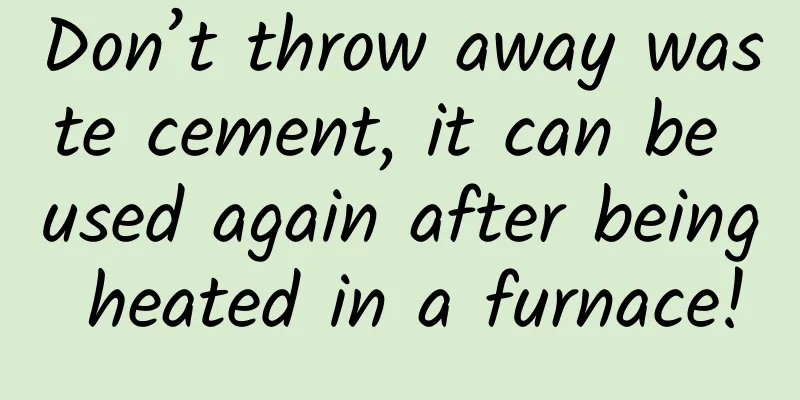Don’t throw away waste cement, it can be used again after being heated in a furnace!

|
□ Right to speak Using electric-powered furnaces to produce steel is a mature technology. If waste cement is used as part of steel production, it can be reused. If it is heated in an electric arc furnace powered by renewable energy, we can get zero-emission cement. Recently, researchers at the University of Cambridge in the UK drew inspiration from traditional iron smelting furnaces and proved for the first time in the world that cement can be recycled without causing harm to the environment like the previous production of synthetic cement. The relevant research results were recently published in the international scientific journal Nature. Concrete is a material that is used in large quantities. In addition to sand and gravel, its main components are cement, which acts as a binder. Limestone and other raw materials are crushed and heated to about 1450°C in large kilns. This process converts the raw materials into cement. In the process of heating to produce quicklime, limestone releases a large amount of carbon dioxide, accounting for about 7.5% of total anthropogenic emissions. Over the past 10 years, scientists have been studying cement substitutes in concrete and found that about half of the cement in concrete can be replaced with materials such as fly ash, but it is unrealistic to completely eliminate cement. How to adopt cost-effective methods to reduce carbon emissions from concrete is one of the world's biggest carbon reduction challenges. In the process of blast furnace ironmaking, in order to reduce the smelting temperature, an appropriate amount of limestone and dolomite are added as flux. These limestone and dolomite are decomposed into calcium oxide, magnesium oxide, iron ore and other substances in the blast furnace, and melted with the ash powder in the coke to form a molten material with silicate and aluminosilicate as the main components, which floats on the surface of the molten iron and is discharged from the slag outlet regularly. It is then cooled by air or water to form granular particles, which is slag. The waste slag produced when the steel plant smelts pig iron contains a large amount of glass and minerals such as dicalcium silicate, calcite, and wollastonite, which are close to the composition of cement. The mineral form of slag that has not been quenched by water is a stable crystal, and most of it is inactive. If it is quenched by water and rapidly cooled, it forms a glassy structure, which makes the slag unstable and has greater potential chemical energy. The higher the slag discharge temperature and the faster the cooling rate, the greater the potential chemical energy of the vitrified slag and the higher the activity. Therefore, the potential activity of blast furnace slag that has been quenched by water and rapidly cooled is better, and 0.3-1 tons of slag should be discharged for every ton of pig iron produced. Slag treatment is the guarantee for the normal operation of blast furnace ironmaking. High-quality slag can be used as high-quality raw material for cement, which can not only reduce costs and improve economic benefits, but also be conducive to the utilization of bulk solid waste, the development of circular economy and environmental protection. Researchers at the University of Cambridge in the UK adjusted the existing steel production process and found that the chemical composition of waste cement is similar to that of limestone. If waste cement is used instead of limestone and added to the ironmaking furnace, the slag produced can be used to make new cement. In this way, cement can be recycled, not only does not require the production of so much new cement, but also reduces carbon dioxide pollution. (The author is a member of Anhui Science Writers Association) |
<<: Can feces be used to treat diseases? Intestinal flora has miraculous effects
Recommend
Solution | 7 industry promotion tips under the influence of the epidemic
The sudden outbreak of the new coronavirus epidem...
Here are all the contents related to China in the report of the Queen of Internet
On the morning of June 2, Mary Meeker, known as t...
10,000 words to dismantle the L’Oreal brand!
As the wave of new brands cools down, the spotlig...
How long will it take for new mobile phone battery technology? Maybe 10 years!
"The batteries of digital devices are too sh...
How to improve user registration conversion and user activation
User registration conversion and user activation ...
In order to improve performance, scientists actually "supplement" semiconductors with vitamin C?
Produced by: Science Popularization China Author:...
What effects will looking down at your phone for a long time have on your body?
The latest data shows that The number of Internet...
Li Guoqing opposes giving extra points to the children of medical staff fighting the epidemic. Is it reasonable to give extra points to the children of medical staff fighting the epidemic?
Recently, Li Guoqing, the founder of Dangdang.com...
Is there a solution to WeChat's space occupation? Experience WeChat's official cleaning function
If we talk about the apps that consume the most m...
Xiaohongshu is in a dilemma, and Mao Wenchao doesn't have much time left
1 E-commerce "hunting" Xiaohongshu A hi...
What are the techniques for Kuaishou operations? Kuaishou operation skills and practice
In recent years, Kuaishou has combined its own po...
China Automobile Dealers Association: China's used car manager index was 48.7% in May 2020
On June 1, 2020, the China Automobile Dealers Ass...
Analyze three classic theories to extract inspiration and skills for advertising creativity
The importance of creativity in advertising has b...
APP advertising: How to choose the right delivery channel?
If you don’t advertise, you’re waiting for death;...
Leeks, cut and grown again, are a favorite on Chinese tables
Written by Wei Shuihua Header image | TuChong Cre...









